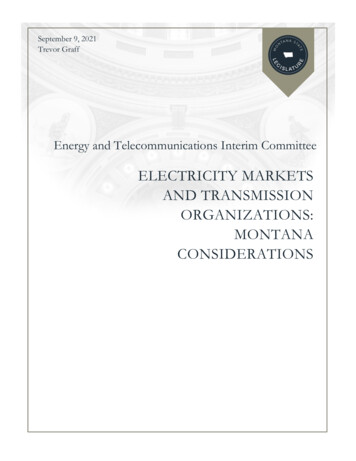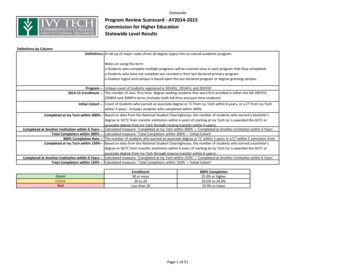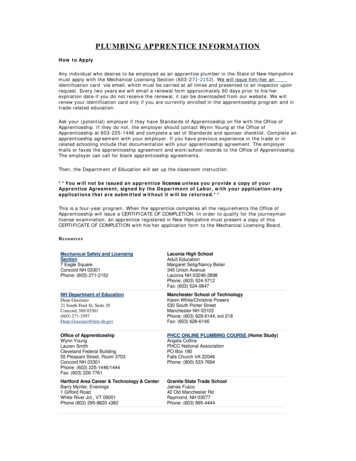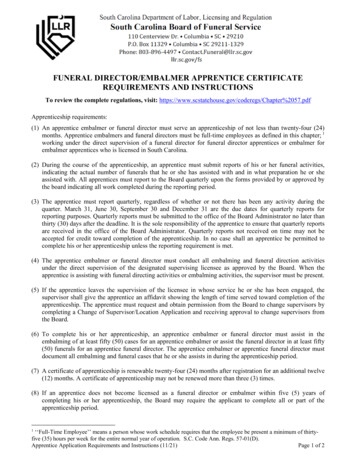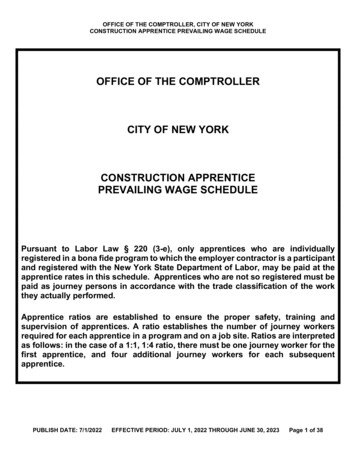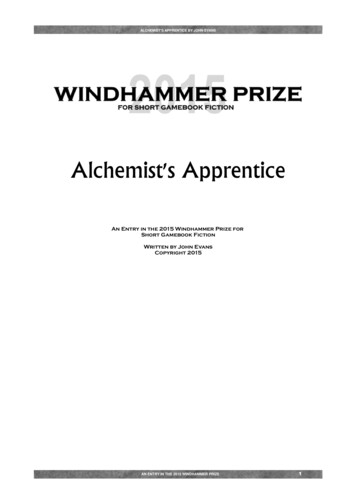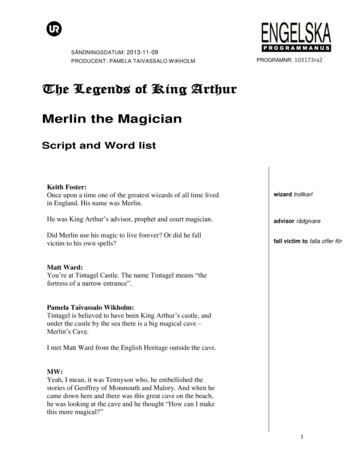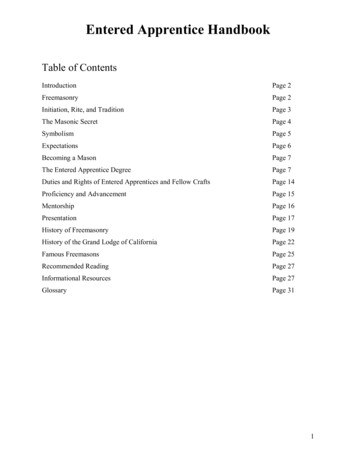
Transcription
Entered Apprentice HandbookTable of ContentsIntroductionPage 2FreemasonryPage 2Initiation, Rite, and TraditionPage 3The Masonic SecretPage 4SymbolismPage 5ExpectationsPage 6Becoming a MasonPage 7The Entered Apprentice DegreePage 7Duties and Rights of Entered Apprentices and Fellow CraftsPage 14Proficiency and AdvancementPage 15MentorshipPage 16PresentationPage 17History of FreemasonryPage 19History of the Grand Lodge of CaliforniaPage 22Famous FreemasonsPage 25Recommended ReadingPage 27Informational ResourcesPage 27GlossaryPage 311
IntroductionWhat is this handbook for and how should it be used?This handbook is designed to introduce the new Entered Apprentice to the vast body ofknowledge associated with Freemasonry in a meaningful and understandable way. It is intendedthat through the intellectual study of Freemasonry the Entered Apprentice will come tounderstand that the application of Masonic teachings in daily life is the most rewarding aspect ofhis new journey. The best way to use this handbook is to read through it as soon as possible, butalso to continue to use it as a reference source in one’s continued Masonic development andstudy of the Masonic mysteries.*In studying Freemasonry, every Mason discovers that there are many aspects to the organization.They can be divided into three main categories—philosophic, historical, and organizational. Thephilosophic aspect of Freemasonry introduces the student to the profound subjects of initiation,symbolism, and tradition, and their potential to impact his life for the better. The historicalaspect teaches the student how the traditions and teachings that make up Masonry came to be,their central role in the spiritual search of mankind, and the way Masonry has affected the worldsince its emergence. The organizational aspect helps the student understand how the organizationis governed and perpetuated, and provides many opportunities for the development of leadershipskills and an improved sense of personal responsibility.While studying Masonic symbolism, history, and organization can be interesting and exciting,the goal is to be able to translate the lessons and experiences that one gains from Masonry intoone’s daily actions. Freemasonry, if approached with humility, an open heart, and an open mind,will make one a gentleman, a better family man, and a better citizen. It should also be understoodthat while Freemasonry is not a religion, it does encourage its members to be active in their ownreligious traditions.FreemasonryWhat is it, what is its purpose, and how does it differ from other organizations?Freemasonry is a traditional initiatic order. It is not a secret society, but rather, a society withsecrets. While it took its modern form during the Enlightenment, its traditions, symbols, andlessons reach back to pre-modern times.The general work associated with the initiatic tradition and the purpose of Freemasonry, putsimply, is to provide an environment where good men can come together to pursue meaningfulintellectual and spiritual growth. It is often said that Freemasonry “makes good men better.” Oneof the underlying tenets of the initiatic tradition is the belief that with each individual thatbecomes a better person, the entire world profits.Being part of the initiatic tradition is what distinguishes Freemasonry from purely social orphilanthropic organizations. While there are many different organizations that contribute largesums of money to charity, offer fellowship with like-minded men, or provide education,Freemasonry is unique in that it embodies all these things, but is actually focused on offeringmen a traditional initiation into the mysteries of life and death. The initiatic tradition is the core,defining characteristic of Freemasonry, without which there would be nothing to differentiateMasonry from other social or philanthropic organizations.*Terms appearing in bold on their first occurrence in this handbook can be found in the Glossary.2
Initiation is a slow and sensitive process and requires great effort on behalf of both the candidateand the existing members of the lodge. For the initiatic experience to be meaningful andenriching, great care and attention must be afforded to each individual candidate. If the newFreemason is to become worthy of the title, he must spend time and energy learning about thehistory, symbolism, and philosophy of the Craft. There is no way around it.The process of experiencing the initiatic tradition, becoming a part of it, and improving oneselfthrough its lessons is known as Masonic Formation. This is an ever-continuing process ofspiritual and intellectual formation that all Freemasons must continuously undergo. MasonicFormation is the process of fitting the Rough Ashlar of our imperfect being into the PerfectAshlar fit for the Divine temple. It is a constant transformation through the use of Masonicsymbols, rituals, and teachings on a journey of return to the center of our being. W. L.Wilmshurst, in his book Meaning of Masonry, writes, “the very essence of the Masonic doctrineis that all men in this world are in search of something in their own nature which they have lost,but that with proper instruction and by their own patience and industry they may hope to find.”Initiation, Rite, and TraditionFreemasonry: a traditional institution that practices rites as a means of preserving and perpetuating theinitiatic tradition.Inherent in the traditional character of Freemasonry is that initiatic rites are viewed as anecessary and perpetual aspect of a Divinely maintained natural order. In this sense,Freemasonry is one of the last remaining institutions of the Western world to preserve andpractice traditional forms. Understanding the terms initiation, rite, and tradition is essential toevery Mason’s development.INITIATIONWhile having a number of meanings and possible interpretations, initiation is foremost a spiritualundertaking. To be initiated into Masonry, particularly in modern times, is a highly significantand meaningful step in one’s life. In a world too often governed by busy schedules, loosetongues, and the accumulation of wealth, Masonry helps provide balance by teaching the valuesof stillness, silence, and selflessness.The term “initiation” comes from the Latin word initiare, which is a late Hellenistic translationof the Greek verb myein. The main Greek term for initiation, myesis, is also derived from theverb myein, which means “to close.” It referred to the closing of the eyes, which was likelysymbolic of entering into darkness prior to reemerging and receiving Light, and to the closing ofthe lips, which was a reference to the vow of silence taken by all initiates.Another Greek term for initiation was telete. On the subject of the immortality of the soul,Plutarch writes that “the soul at the moment of death goes through the same experiences as thosewho are initiated into the great mysteries. The word and the act are similar: We say telentai (todie) and telestai (to be initiated).” The fact that myein means “to close” and its Latin translation,initiare, is derived from the earlier inire, which means “to go in” or “to begin,” further suggeststhat a notion of endings and beginnings was inherent to the ancient understanding of these terms.With this understanding, initiation is a new undertaking, the beginning of a new, spiritual life.3
RITEThe word rite is derived from the Latin ritus, which comes from the Sanskrit ri, meaning to flow,and is usually associated with a running stream or a way. This term is closely linked by itsdefinition with the term tradition and denotes the continuous performance or preservation ofsomething sacred associated with the Divine.TRADITIONThe word tradition derives from the Latin traditus, past participle of tradere, meaning to give ordeliver into the hands of another, to entrust. This word also has Indo-European roots comingfrom trans, meaning to give. With this understanding, tradition is transmission. It is the handingdown of knowledge and far more than mere repetition.Tradition is that which has kept its original character and retains its transcendent aspect.Freemasons are concerned with that part of tradition that is most inward and elevated, and thus,what constitutes its very spirit and essence. Tradition also means permanence in what is essentialand integrity of principles. One of the Ancient Charges of Freemasonry, repeated at theinstallation ceremonies of many jurisdictions, including ours, states that “You admit that it is notin the power of any man, or body of men, to make innovations in the body of Masonry.” For tomake innovations may break the transmission.The Masonic SecretIneffable and incommunicable.While Freemasonry is an association that has rules, regulations, archives, and minutes, only thedirect and oral transmission can communicate the spiritual influence which is the fundamentalpurpose of every initiatic organization. An uninitiated person who knew all the rites from havingread their descriptions in books would still not be initiated in any way, for the spiritual influenceinherent in those rites would in no way have been transmitted to him. Since the Masonic secret isof such a nature that words cannot express it, initiatic teaching can only use rites and symbolsthat suggest rather than express. The interior work of the individual, using the symbols as baseand support, will allow each initiate to attain that secret and penetrate it more or less completely,more or less profoundly, according to the measure of his own possibilities of comprehension andrealization.In making his journey through Masonry, the initiate learns that the traditional forms used by aninitiatic organization are fundamentally something other than how they appear from the outside,and this is what essentially distinguishes them from profane forms, where the outwardappearance is everything and does not conceal any reality of another order.One consequence of this difference is that secrets of an exterior order can always be betrayed,whereas the initiatic secret can never be betrayed since it is inaccessible to and ungraspable bythe uninitiated and therefore cannot be penetrated, since knowledge of it can only be theconsequence of initiation itself.4
Since this secret is of such a nature that words cannot express it, initiatic teaching can only userites and symbols that suggest rather than express. Properly speaking, what is transmitted by theinitiatic rite is not the secret itself, since this is incommunicable, but the spiritual influence thatstimulates the initiate’s inner process of discovery.SymbolismThe expression of relationships.Symbolism in its most basic sense means using one thing to represent another. Words, signs, andgestures are all forms of symbols. Freemasons, however, study symbolism in a deeper sense.The term symbolism is derived from the Greek symbolon, which was a token of identity verifiedby comparing with its other half. In this sense, symbols are the representation or affirmation of aconcept or truth by reason of relationship or unity of parts. The meaning represented by thesymbol is actually greater than the whole of its parts.Freemasons are concerned with this aspect of symbolism, the gathering of what is scattered, as ameans of better understanding the whole of existence. By gathering knowledge from the spiritualtraditions of the world and uniting good men who otherwise would have stood apart,Freemasonry serves as the center of union in the Mason’s quest for the truth. Benefiting from themeanings and truth we find hidden within symbols requires synthesis, association, andapplication. Each symbol, when properly perceived by the knowing initiate, reflects the innerrelationship between the material and spiritual world and thereby reveals the reality of a higherorder. Seriously studying symbolism is an important aspect of growing in Freemasonry.Freemasonry makes extensive use of symbolism and allegory. Research into the historical usesand meanings of symbols utilized in the rituals, as well as a comparative study of mythology,provides a strong foundation for Masonic knowledge. Also recommended to Masonic researchersis a working knowledge of the contents of the Bible. Whenever a person or event is explicitlymentioned or alluded to in the rituals of Masonry, it may be important to find out why.In Masonry, the lodge is the center of activity. It represents the Temple of Solomon and alldegree work (ritual) and advancement is done within the Temple. The Temple is considered to bean exact replica of the Divine world. It is sacred; it is the center of the universe. Its structure,furnishings, dimensions, and proportions—its architecture—are a mirror image of the Divine. Itis sacred space, reflecting a higher order. The Temple is the place where the human is mostlikely to encounter the Divine.The Temple of Solomon was built on a giant stone in Jerusalem which, according to Jewishtradition, is the center of the universe. The importance of stones is pervasive in religious thought.References connecting stones with the gods reach back to the earliest times. It has beenconsidered by some religious historians as being an archetypal image representing absolutereality. Many of the old gods, such as Mithras, were thought to be born from stones (petragenitrix). Stones possess the qualities of stability, solidity, and everlastingness, which are alsoqualities attributed to the gods. There are numerous references to stones throughout the Biblewhich allude to a link between the stone, the sacred, and spirituality. In Isaiah 28:16 we read:“Therefore thus saith the Lord God, Behold, I lay in Zion for a foundation a stone, a tried stone,a precious corner stone, a sure foundation.” In Psalm 118:22 we find: “The stone which thebuilders refused is become the head stone of the corner.” Also, in Revelation 2:17 we read: “To5
him that overcometh will I give to eat of the hidden manna, and will give him a white stone, andin the stone a new name written, which no man knoweth saving he that receiveth it.”ExpectationsSome things to consider about Freemasonry and personal responsibility.If the purpose of Freemasonry is “to make good men better,” men should become Freemasonsonly if they are good and consider themselves capable of becoming better. Determining thequalifications of men seeking admission is an essential aspect of upholding the integrity of ourancient institution. The investigative procedures of lodges are designed to ensure that theBrethren of the lodge have sufficient information about the candidates they vote on.Ritual is intended to be performed in a solemn manner to provide the most meaningfulexperience possible for the candidates and the membership. Creating an atmosphere that maylead to a positive transformation of the individual is the goal of Masonic ritual.Time between degrees should be used for intellectual study, contemplation, and selfdevelopment. Candidates should demonstrate some degree of improvement in theirunderstanding of Freemasonry before being advanced to the next degree. When this is properlyobserved, every Mason grows into a better man and the bonds of virtue that tie together thebrotherhood of humanity are strengthened.It is intended that lodges provide their candidates with instruction about the teachings andsymbols of Freemasonry. Qualified Masons are always encouraged to provide Masonicinstruction to their Brethren in the form of presentations, answering questions, and promotingdiscussion. The focus of the Mason’s intellectual and philosophical development should be onapplying the teachings of Freemasonry in his daily life.Freemasonry helps teach the importance and benefits of duty and service. If every Mason workshard and takes responsibility in all he does, then Masonry will thrive. Masons are expected toattend all meetings of their lodge, and if unable to do so, inform a brother or the Secretary of thelodge of the reason in advance.Officers of a Masonic lodge serve in their offices as a privilege and not as a right. It is intendedthat brothers attain positions of responsibility only after having demonstrated their good faith,ability to make a serious time commitment, and sincere desire to correctly perform the necessaryduties. The election of the Master is always of importance, and only those Brethren should beconsidered for this honor and responsibility who are well versed in Masonic teachings, who havethe resourcefulness to lead, and whose personal character can serve as an example to befollowed.6
Becoming a MasonQUALIFICATIONS OF A PETITIONERThe qualifications to be a Mason are clear and distinct. There are physical, moral, and spiritualqualifications. In California, the petitioner must be a man of at least 18 years of age. He must befree of any previous felonious criminal convictions and be of good moral character. He must alsobelieve in a Supreme Being and the immortality of the soul. The physical qualifications arenecessary because the person must be free to make his own life decisions and be responsible forhimself. The moral qualifications are self-evident for the viability of any brotherhood and thelofty ideals of our society. The spiritual qualifications support the structure of Freemasonry andaffirm its consistency with the great Mystery Schools and religions of the world.THE SECRET BALLOTAfter a man has applied for Masonic membership, and his background has been thoroughlyinvestigated, the lodge members vote by secret ballot to accept or to reject him for membership.Masonry’s secret ballot is another of its ancient customs. It has been rather aptly said that when apetitioner is voted upon for Masonic membership, he undergoes the “Ordeal of the SecretBallot.” To be elected, he must receive an affirmative vote from each and every member presentat that meeting.The Entered Apprentice DegreePREPARATION FOR INITIATIONIf a man senses the stirrings in his heart for a deeper understanding of life than that he hasheretofore found, he will seek until he finds the fraternity. This longing of the heart is thebeginning of his initiation, which is why each candidate who comes seeking Light is said to befirst prepared in his heart. While Freemasonry is not a religion, its rites are of a serious nature,dignified in their presentation, and which impart teachings that, if properly understood, obligatea man to lead a better life. To get the greatest good from the rites, a candidate should prepare hismind and heart to understand and absorb the teachings of Masonry. The candidate should payclose attention to every part of the ritual. The forms of the rituals may be new and unusual to thecandidate, but such forms have always been part of the initiatic traditions of the world.DULY AND TRULY PREPAREDBeing duly and truly prepared refers to being divested of all minerals and metals to emphasizethe concern with a man’s internal qualifications, rather than his worldly wealth and honors. Byundergoing the special preparation, the candidate signifies the sincerity of his intentions. Beingduly and truly prepared also refers to the state of a man’s heart and soul as he seeks admissioninto our Order. “Seek and ye shall find. Ask and it shall be given unto you. Knock and it shall beopened unto you.”7
THE HOODWINKThe symbolism of the hoodwink is twofold: First, it emphasizes the veil of secrecy and silencesurrounding the mysteries of Freemasonry; second, it represents the mystical darkness, orignorance, of the uninitiated. It is removed at the appropriate time, that is, when the candidate isin the proper state to receive Light.THE CABLE-TOWThe cable-tow is a rope such as would be used to tow or restrain. It is also generally regarded asa symbol of the voluntary and complete acceptance of, and pledged compliance with, whateverMasonry may have in store. The cable-tow is also symbolic of the candidate’s attachment to theoutside world.The length of the cable-tow is frequently referred to in the language of Freemasonry, but manyof the new Brethren do not understand its meaning. Formerly, a cable-tow was deemed to be thedistance one could travel in an hour, which was assumed to be about three miles. In Masonry,this is any reasonable distance from which a summons may be answered, health, family, andbusiness permitting. Each Mason is bound to all other Masons by a tie as long and as strong as hehimself determines his ability will permit. One may also consider the idea of the silver cord(Ecclesiastes 12:6) as the cable-tow.ENTERING THE LODGEAs an Entered Apprentice takes his first step into the lodge room, he enters into a new world: theworld of Masonry. He leaves the darkness, destitution, and helplessness of the world for the lightand warmth of this new existence. It is not an idle formality, but a genuine experience, thebeginning of a new life in which duties, rights, and privileges are real. Entrance into the lodge issymbolic of the movement from the outer to the inner, from the world of material senses into theworld of his true self.If a candidate is not to be an Apprentice in name only, he must stand ready to do the work uponhis own nature that will make him a different man. Freemasonry offers no privileges or rewardsexcept to those who earn them; it places working tools, not playthings, in the hands of itsmembers. To become a Mason is a solemn and serious undertaking. Once the step is taken, it willchange the course of a man’s life for the better.THE METHOD OF RECEPTIONThe reception of the candidate into the lodge room is intended to symbolize the fact that ourrituals are serious and confidential and that there are consequences for violating this confidence.It also reminds a man that his every act has a consequence, either in the form of a reward or apenalty. The method of reception also points out the value of a certain virtue needed to gainadmission into the mysteries of Masonry.8
PRAYER IN LODGEA lodge cannot be opened or closed without prayer, which is offered by the Master or Chaplain.The prayer is universal in nature, and not peculiar to any one religion or faith. The act ofinvoking the blessings of Deity, however, is a central Masonic practice. At the end of prayer,each member responds with the words “So Mote It Be,” which is an older phrase meaning “Somay it ever be.”THE PRACTICE OF CIRCUMAMBULATIONCircumambulation means to walk around some central point or object. In Masonry, the act isperformed in a clockwise manner, patterned after the movement of the sun as it is seen from theearth, moving from east to west, by way of the south. The candidate’s journey around the altaralso enables the Brethren to observe that he is properly prepared. Circumambulation is an ancientpractice found all over the world. Much the same idea as the labyrinth, it portrays the path ofinitiation as that of a journey. In another sense, it symbolically aligns one to a proper relationshipwith the order of the universe by outlining the circumference of one’s life to direct attention tothe spiritual at the center.KNEELING AT THE ALTARThe central piece of furniture in the lodge is the altar. The altar is symbolic of many things. As atemple symbolizes the presence of Deity, the altar symbolizes the point of contact. Its location, inthe center of the lodge, also symbolizes the place which God has in Masonry, and which Heshould have in every person’s life. It is also a symbol of worship and faith. The candidateapproaches the altar in search of Light and also assumes his Obligations there. In the presence ofGod and his Brethren, he offers himself to the service of the Supreme Architect of the Universeand to mankind in general. The altar is the point on which life in our Masonic lodges is focused,and it should be accorded the highest respect.The wisdom of the Master is said to flow from his station in the east to the altar. Thus, oneshould never cross between the Master’s station and the altar when a lodge is convened.THE OBLIGATIONThe Obligation is the heart of the degree; for when it is assumed by the candidate, he hassolemnly bound himself to Freemasonry and assumed certain duties which are his for the rest ofhis life. The taking of the Obligation is visible and audible evidence of the candidate’s sincerityof purpose. In addition to binding the candidate to Freemasonry and its duties, the Obligationalso protects the fraternity against someone revealing the modes of recognition and symbolicinstruction.Like much in the fraternity, the roots of this practice are ancient. Making vows was a commonpractice in the Ancient Mysteries and was even a form of personal religion to the generalpopulace. In many ways, the vow defined their relationship with the deities of their homeland.Many vows were expressed in terms such as promises to a deity in return for safe voyages,successful crops, healing, and so on. Although the nature of making vows and Obligations haschanged in modern times, it remains a very powerful method for setting direction in one’s lifeand the building of character. The Latin obligato literally signifies a tying or binding. The9
relationship between the cable-tow and the Obligation, along with the changing nature of thisrelationship as the candidate progresses, should not go unnoticed.The ancient symbolic penalties are retained in our ritual to impress upon the mind of eachbrother how seriously a violation will be regarded by members of the fraternity. The Obligationswere voluntarily assumed, and every means possible is used to impress the new Mason with theirsolemnity and the necessity of performing them faithfully.THE THREE GREAT LIGHTS OF MASONRYThe Three Great Lights of Masonry are the Holy Bible, square, and compass. The Volume of theSacred Law (VSL) is an indispensable part of the furniture of a lodge. The Grand Lodges of theUnited States use the Holy Bible as the VSL on their altars. In our jurisdiction, a candidate mayrequest to have his own sacred book present on the altar with the Bible during his degreeceremonies. In some lodges in other countries, other sacred texts are placed on the altar in placeof the Holy Bible, but no lodge in California may stand officially open unless the Holy Bible isopened upon its altar with the square and compass displayed thereon. The open Bible signifiesthat we should regulate our conduct according to its teachings because it is the rule and guide ofour faith and is a symbol of man’s acknowledgment of his relation to Deity.The square is a symbol of morality, truthfulness, and honesty. To “act on the square” is to acthonestly. The compass signifies the propitious use of action and is a symbol of restraint, skill,and knowledge. We might also properly regard the compass as excluding beyond its circle thatwhich is harmful or unworthy. The square and compass are recognized by the general public asthe symbol of Freemasonry.The symbolism of the square and compass is seen in many ancient carvings and artworks. Astonecutter’s square has been seen to represent the earth, while the compass was related to thearc of heaven. Thus their union is symbolic of the union of heaven and earth. The VSL can alsorepresent God’s communication to man through scripture and revelation. The VSL combinedwith the united square and compass can also be seen as representing God’s expression throughthe creation of heaven and earth.The Three Great Lights are also consistent with the three-tier system of Ancient Craft Masonry.One way of interpreting the triple symbolism is seeing human nature as divided into threeparts—body, intellect, and soul—with a degree for each part. In the same way, The Three GreatLights can be viewed as the guiding principles of the three natures: the square for the body, thecompass for the intellect, and the Volume of Sacred Law for the soul.PRESENTATION OF THE LAMBSKIN APRONThe apron is at once an emblem of innocence and the badge of a Mason. By innocence is meantclean thinking and clean living, a loyal obedience to the laws of the Craft, and sincere goodwilltoward one’s Brethren. The “Badge of a Mason” signifies, among other things, that Masons areworkers and builders.The apron as a mark of distinction has been found in many similar organizations of initiaticnature including the Essenes and the Mithraic Mysteries, and has been conspicuous on statues ofsome Egyptian and Greek deities. The lamb has always been a symbol of innocence andsacrifice. There are two senses in which innocence is being used here. Innocence in one sense isfree from moral defect. The other sense used is that of being newly born.10
Another consideration of the white lambskin apron is that the Sign of the Ram begins at theSpring Equinox—the time of year that life is renewed. The Masonic apron is made up of twoparts: a square and a triangle, representing four and three, respectively. The symbolism of thesenumbers, as well as their sum, should be studied in connection with the form of the apron in thedifferent degrees. Finally, it should be mentioned that the word candidate comes from the Latincandidatus, which means “clothed in white.”THE RITE OF DESTITUTIONThe symbolism of the Rite of Destitution reverts to those ancient times when men believed thatthe planets determined human fate and controlled human passions, and that there were metals bywhich each planet was itself controlled. In ancient initiations, candidates were compelled toleave all metals behind, lest they bring into the assembly disturbing planetary influences. Thecandidate is not to bring into the lodge room his passions or prejudices, lest that harmony, whichis one of the chief concerns of Masonry, be destroyed.WORKING TOOLS OF AN ENTERED APPRENTICEThe working tools presented to the candidate were those used by the ancient operative craftsmanin the erection of the building on which he was working. To the speculative Mason, theserepresent the moral habits and forces by which man shapes and reshapes himself. By thesesymbolic too
that while Freemasonry is not a religion, it does encourage its members to be active in their own religious traditions. Freemasonry What is it, what is its purpose, and how does it differ from other organizations? Freemasonry is a traditional initiatic order. It is not a secret society, but rather, a society with secrets.
